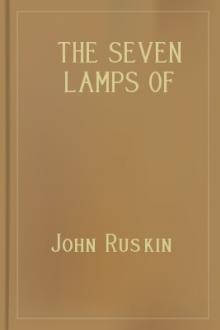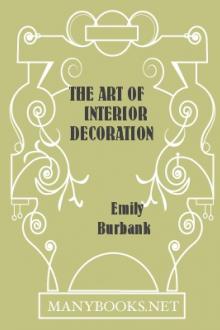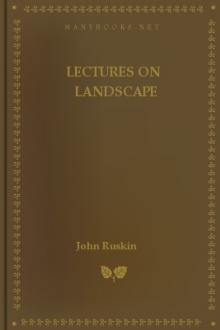The Seven Lamps of Architecture by John Ruskin (books like harry potter TXT) 📕

- Author: John Ruskin
- Performer: -
Book online «The Seven Lamps of Architecture by John Ruskin (books like harry potter TXT) 📕». Author John Ruskin
In the same clause with the portcullis, we may condemn all heraldic decoration, so far as beauty is its object. Its pride and significance have their proper place, fitly occurring in prominent parts of the building, as over its gates; and allowably in places where its legendary may be plainly read, as in painted windows, bosses of ceilings, &c. And sometimes, of course, the forms which it presents may be beautiful, as of animals, or simple symbols like the fleur-de-lis; but, for the most part, heraldic similitudes and arrangements are so professedly and pointedly unnatural, that it would be difficult to invent anything uglier; and the use of them as a repeated decoration will utterly destroy both the power and beauty of any building. Common sense and courtesy also forbid their repetition. It is right to tell those who enter your doors that you are such a one, and of such a rank; but to tell it to them again and again, wherever they turn, becomes soon impertinence, and at last folly. Let, therefore, the entire bearings occur in few places, and these not considered as an ornament, but as an inscription; and for frequent appliance, let any single and fair symbol be chosen out of them. Thus we may multiply as much as we choose the French fleur-de-lis, or the Florentine giglio bianco, or the English rose; but we must not multiply a King's arms.
IX. It will also follow, from these considerations, that if any one part of heraldic decoration be worse than another, it is the motto; since, of all things unlike nature, the forms of letters are, perhaps, the most so. Even graphic tellurium and felspar look, at their clearest, anything but legible. All letters are, therefore, to be considered as frightful things, and to be endured only upon occasion; that is to say, in places where the sense of the inscription is of more importance than external ornament. Inscriptions in churches, in rooms, and on pictures, are often desirable, but they are not to be considered as architectural or pictorial ornaments: they are, on the contrary, obstinate offences to the eye, not to be suffered except when their intellectual office introduces them. Place them, therefore, where they will be read, and there only; and let them be plainly written, and not turned upside down, nor wrong end first. It is an ill sacrifice to beauty to make that illegible whose only merit is in its sense. Write it as you would speak it, simply; and do not draw the eye to it when it would fain rest elsewhere, nor recommend your sentence by anything but a little openness of place and architectural silence about it. Write the Commandments on the Church walls where they may be plainly seen, but do not put a dash and a tail to every letter; and remember that you are an architect, not a writing master.
X. Inscriptions appear sometimes to be introduced for the sake of the scroll on which they are written; and in late and modern painted glass, as well as in architecture, these scrolls are flourished and turned hither and thither as if they were ornamental. Ribands occur frequently in arabesques,—in some of a high order, too,—tying up flowers, or flitting in and out among the fixed forms. Is there anything like ribands in nature? It might be thought that grass and sea-weed afforded apologetic types. They do not. There is a wide difference between their structure and that of a riband. They have a skeleton, an anatomy, a central rib, or fibre, or framework of some kind or another, which has a beginning and an end, a root and head, and whose make and strength effects every direction of their motion, and every line of their form. The loosest weed that drifts and waves under the heaving of the sea, or hangs heavily on the brown and slippery shore, has a marked strength, structure, elasticity, gradation of substance; its extremities are more finely fibred than its centre, its centre than its root; every fork of its ramification is measured and proportioned; every wave of its languid lines is love. It has its allotted size, and place, and function; it is a specific creature. What is there like this in a riband? It has no structure: it is a succession of cut threads all alike; it has no skeleton, no make, no form, no size, no will of its own. You cut it and crush it into what you will. It has no strength, no languor. It cannot fall into a single graceful form. It cannot wave, in the true sense, but only flutter: it cannot bend, in the true sense, but only turn and be wrinkled. It is a vile thing; it spoils all that is near its wretched film of an existence. Never use it. Let the flowers come loose if they cannot keep together without being tied; leave the sentence unwritten if you cannot write it on a tablet or book, or plain roll of paper. I know what authority there is against me. I remember the scrolls of Perugino's angels, and the ribands of Raphael's arabesques, and of Ghiberti's glorious bronze flowers: no matter; they are every one of them vices and uglinesses. Raphael usually felt this, and used an honest and rational tablet, as in the Madonna di Fuligno. I do not say there is any type of such tablets in nature, but all the difference lies in the fact that the tablet is not considered as an ornament, and the riband, or flying scroll, is. The tablet, as in Albert Durer's Adam and Eve, is introduced for the sake of the writing, understood and allowed as an ugly but necessary interruption. The scroll is extended as an ornamental form, which it is not, nor ever can be.
XI. But it will be said that all this want of organisation and form might be affirmed of drapery also, and that this latter is a noble subject of sculpture. By no means. When was drapery a subject of sculpture by itself, except in the form of a handkerchief on urns in the seventeenth century and in some of the baser scenic Italian decorations? Drapery, as such, is always ignoble; it becomes a subject of interest only by the colors it bears, and the impressions which it receives from some foreign form or force. All noble draperies, either in painting or sculpture (color and texture being at present out of our consideration), have, so far as they are anything more than necessities, one of two great functions; they are the exponents of motion and of gravitation. They are the most valuable means of expressing past as well as present motion in the figure, and they are almost the only means of indicating to the eye the force of gravity which resists such motion. The Greeks used drapery in sculpture for the most part as an ugly necessity, but availed themselves of it gladly in all representation of action, exaggerating the arrangements of it which express lightness in the material, and follow gesture in the person. The Christian sculptors, caring little for the body, or disliking it, and depending exclusively on the countenance, received drapery at first contentedly as a veil, but soon perceived a capacity of expression in it which the Greek had not seen or had despised. The principal element of this expression was the entire removal of agitation from what was so pre-eminently capable of being agitated. It fell from their human forms plumb down, sweeping the ground heavily, and concealing the feet; while the Greek drapery was often blown away from the thigh. The thick and coarse stuffs of the monkish dresses, so absolutely opposed to the thin and gauzy web of antique material, suggested simplicity of division as well as weight of fall. There was no crushing nor subdividing them. And thus the drapery gradually came to represent the spirit of repose as it before had of motion, repose saintly and severe. The wind had no power upon the garment, as the passion none upon the soul; and the motion of the figure only bent into a softer line the stillness of the falling veil, followed by it like a slow cloud by drooping rain: only in links of lighter undulation it followed the dances of the angels.
Thus treated, drapery is indeed noble; but it is as an exponent of other and higher things. As that of gravitation, it has especial majesty, being literally the only means we have of fully representing this mysterious natural force of earth (for falling water is less passive and less defined in its lines). So, again, in sails it is beautiful because it receives the forms of solid curved surface, and expresses the force of another invisible element. But drapery trusted to its own merits, and given for its own sake,—drapery like that of Carlo Dolci and the Caraccis,—is always base.
XII. Closely connected with the abuse of scrolls and bands, is that of garlands and festoons of flowers as an architectural decoration, for unnatural arrangements are just as ugly as unnatural forms; and architecture, in borrowing the objects of nature, is bound to place them, as far as may be in her power, in such associations as may befit and express their origin. She is not to imitate directly the natural arrangement; she is not to carve irregular stems of ivy up her columns to account for the leaves at the top, but she is nevertheless to place her most exuberant vegetable ornament just where Nature would have placed it, and to give some indication of that radical and connected structure which Nature would have given it. Thus the Corinthian capital is beautiful, because it expands under the abacus just as Nature would have expanded it; and because it looks as if the leaves had one root, though that root is unseen. And the flamboyant leaf mouldings are beautiful, because they nestle and run up the hollows, and fill the angles, and clasp the shafts which natural leaves would have delighted to fill and to clasp. They are no mere cast of natural leaves; they are counted, orderly, and architectural: but they are naturally, and therefore beautifully, placed.
XIII. Now I do not mean to say that Nature never uses festoons: she loves them, and uses them lavishly; and though she does so only in those places of excessive luxuriance wherein it seems to me that architectural types should seldom be sought, yet a falling tendril or pendent bough might, if managed with freedom and grace, be well introduced into luxuriant decoration (or if not, it is not their want of beauty, but of architectural fitness, which incapacitates them for such uses). But what resemblance to such example can we trace in a mass of all manner of fruit and flowers, tied heavily into a long bunch, thickest in the middle, and pinned up by both ends against a dead wall? For it is strange that the wildest and most fanciful of the builders of truly luxuriant architecture never ventured, so far as I know, even a pendent tendril; while the severest masters of the revived Greek permitted this extraordinary piece of luscious ugliness to be fastened in the middle of their blank surfaces. So surely as this arrangement is adopted, the whole value of the flower work is lost. Who among the crowds that gaze upon the building ever pause to admire the flower work of St. Paul's? It is as





Comments (0)